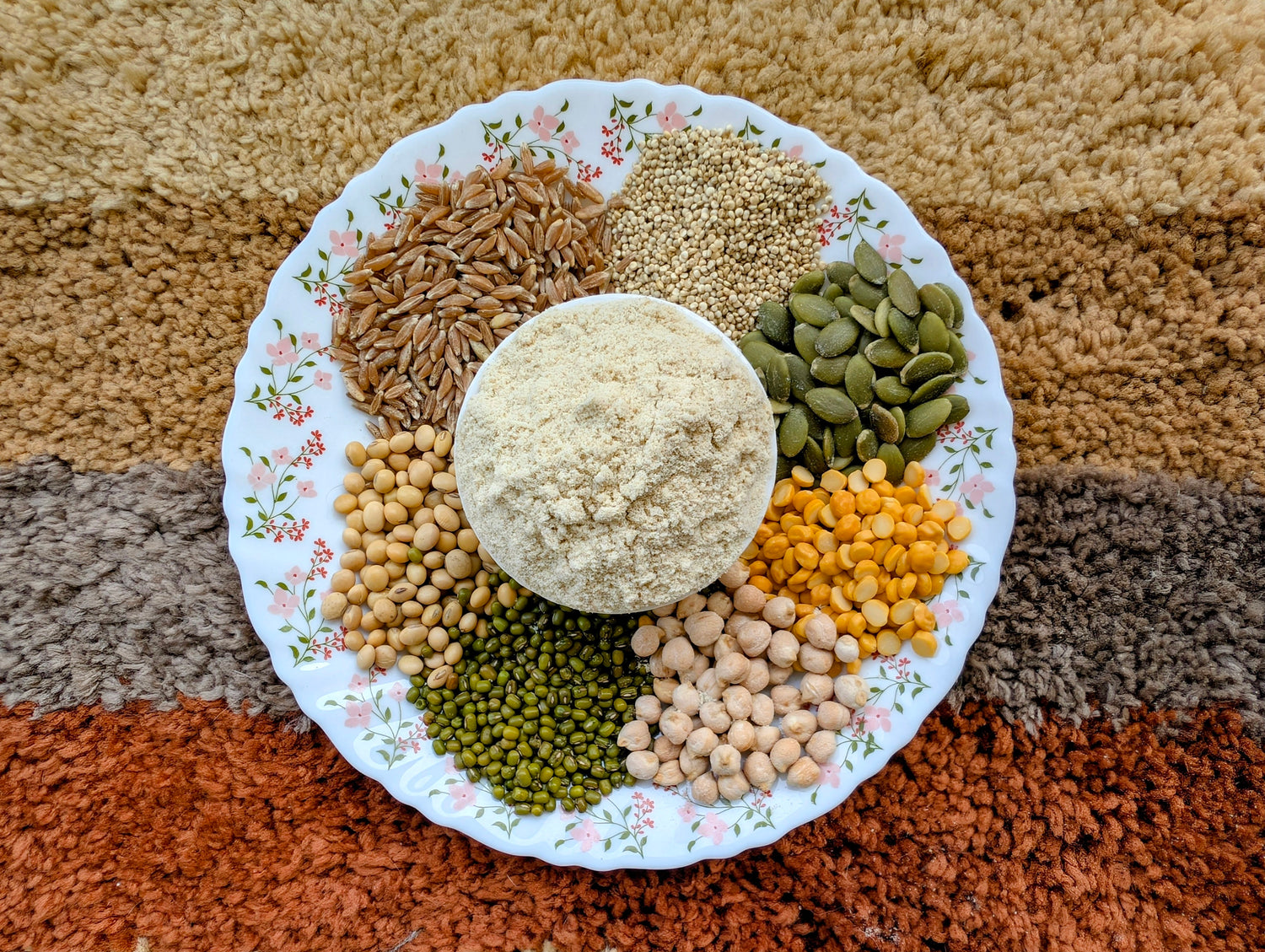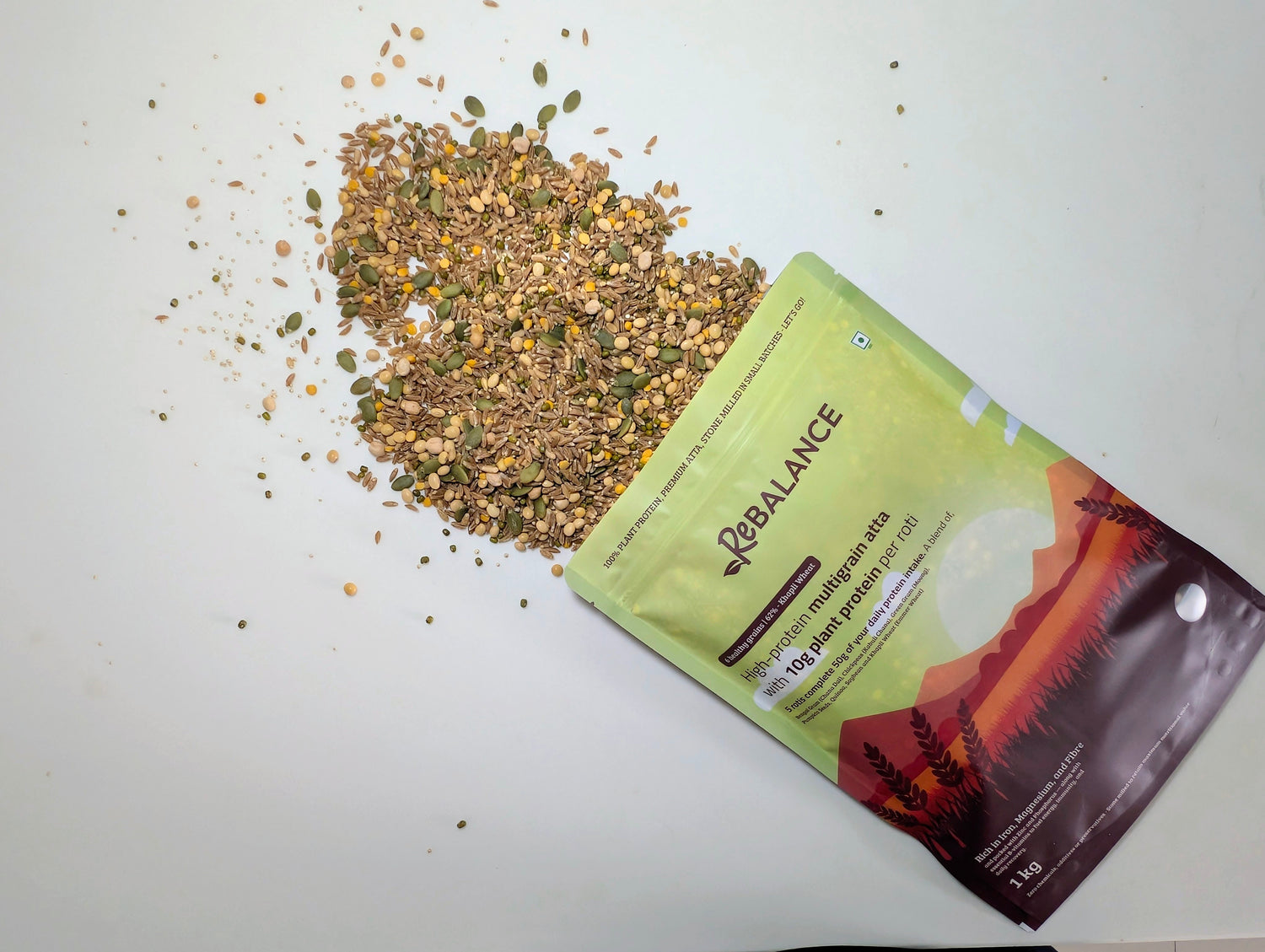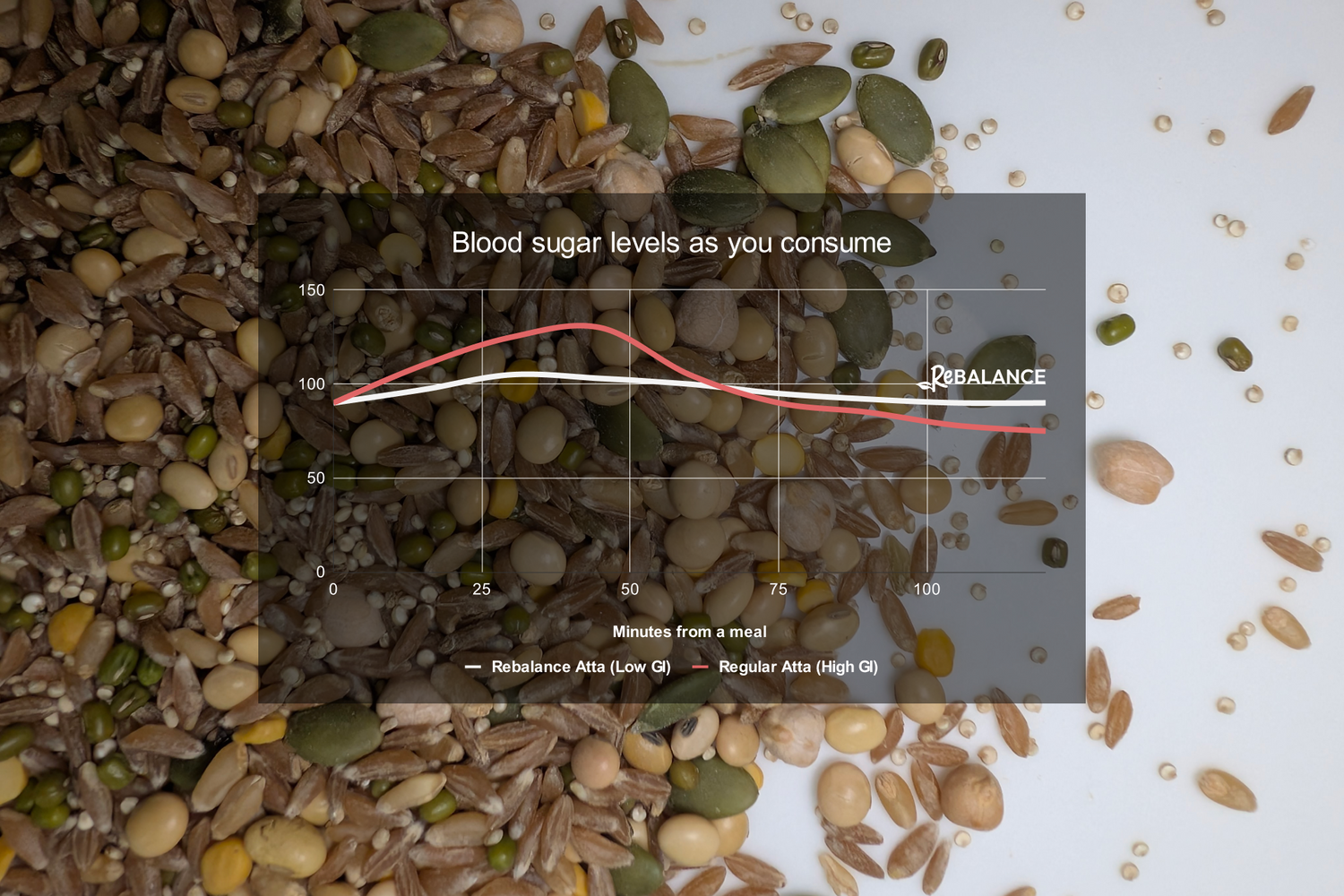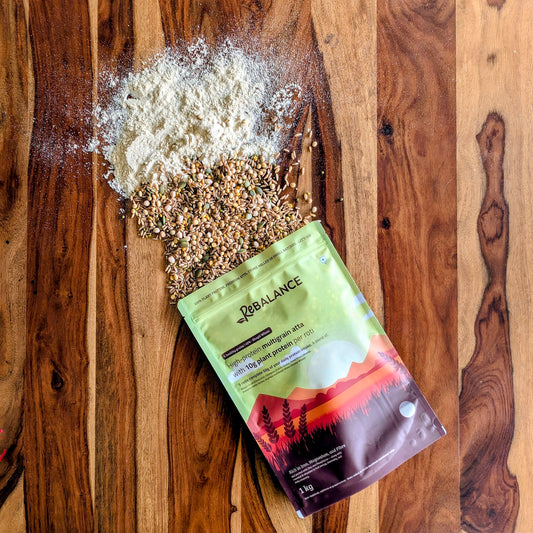




Rebalance isn’t just atta. It’s how modern India eats better.
Born in an army household, perfected for today’s families — Rebalance blends ancient grains, pulses, and seeds to give you 10g of protein per roti. No shortcuts. No preservatives. Just clean, plant-powered nutrition that works with your body, not against it.
High protein. Slow carbs. Zero compromise.

A blend of 7
- Bengal Gram (Chana Dal)
- Chickpeas (Kabuli Chana)
- Green Gram (Moong)
- Pumpkin Seeds
- Quinoa
- Soybean
- Khapli Wheat (Emmer Wheat)

Rich in Iron, Magnesium, and Fibre
and packed with Zinc and Phosphorus — along with essential B-vitamins to fuel energy, immunity, and daily recovery.

Low Glycemic index (< 50)
High in fiber, protein, and healthy fats, which help with slow glucose release
Our customers can't get enough of it
Shop now-

Bhaswati
★★★★★
"I love how good it tastes. The feel toh is awesome. It's so soft and melts in the mouth!"
-

Rohit
★★★★★
"Good morning aunty. We made the chapatis yesterday and it they were super soft and tasty. Even my cook was appreciating the atta. It is an excellent product and will be taken hand to hand instantly by customers. 👏🙏"
-
Manasa
★★★★★
"Hi aunty, upon Daddy's recommendation, i just tried this protein-rich chapathi atta today and I’m impressed! The rotis turned out super soft, flavorful, and wholesome. Love the fact on the packaging that , 5 rotis give 50g protein, covering daily needs. Tasty, healthy, and totally worth it - highly recommend ! 👌"
-

Aishwarya
★★★★★
"I tried making protein dosa with rebalance. They came out really good and soft and taste really good. 😄"
5 rotis complete 50g of your daily protein intake.
Comes in three sizes
-
Rebalance High Protein Multigrain atta - 1 kg
Regular price Rs. 290.00Regular priceRs. 440.00Sale price Rs. 290.00Sale -
Rebalance High Protein Multigrain atta - 2 kgs
Regular price Rs. 560.00Regular priceRs. 880.00Sale price Rs. 560.00Sale -
Rebalance High Protein Multigrain atta - 5 kgs
Regular price Rs. 1,350.00Regular priceRs. 2,200.00Sale price Rs. 1,350.00Sale
FAQs
What makes Rebalance Atta different from regular atta?
Rebalance Atta delivers 10g of plant protein per roti, compared to just 2–3g in regular wheat atta. It’s made from a carefully selected blend of ancient grains, pulses, and seeds — like Khapli Wheat, Soybean, Quinoa, and Moong — with no preservatives, no fillers, and no gimmicks.
What ingredients go into Rebalance Atta?
Our blend includes:
Khapli (Emmer) Wheat, Bengal Gram (Chana Dal), Kabuli Chana, Green Moong, Soybean, Quinoa, and Pumpkin Seeds.
Each one is selected for its protein, fibre, and micronutrient profile — giving you both taste and function in every bite.
How much protein is in one roti made with Rebalance Atta?
Each medium roti made from Rebalance Atta contains approximately 10g of protein — making it an easy and natural way to meet your daily protein needs, especially on a vegetarian or plant-based diet.
Is it safe for kids?
Absolutely. Rebalance is an excellent choice for children — especially those with high activity levels or picky eating habits. It supports better growth, sustained energy, and nutrient density in daily meals.
Is Rebalance gluten-free?
No, Rebalance is not gluten-free as it contains Khapli wheat (a low-gluten ancient grain) and other gluten-containing ingredients. However, it is lower in gluten than regular atta and may be gentler on digestion for many.
How should I store Rebalance Atta?
Since it contains no preservatives, store Rebalance in an airtight container in a cool, dry place.
Can I use Rebalance Atta just like regular atta?
Yes! You can use Rebalance for rotis, parathas, pooris, even baking. The taste is slightly nuttier due to the pulses and seeds — but the texture is soft and familiar. We recommend trying a basic roti first to see how easily it fits into your everyday cooking.
Does it taste different from regular wheat atta?
It has a mildly nutty, earthy flavour, thanks to the pulses, seeds, and ancient wheat. Most customers find the taste richer and more satisfying — and it pairs beautifully with Indian meals.
Who is Rebalance Atta ideal for?
- Vegetarians/Vegans looking to increase daily protein intake
- Health-conscious professionals & gym-goers
- Young parents who want better nutrition for their families
- Anyone managing blood sugar or energy crashes
Blog posts
View all-

What Is Multigrain Atta? Why Most Brands Mislea...
Multigrain atta is marketed as a healthier alternative to wheat flour, but most products rely on vague claims and misleading labels. This research-backed guide explains what multigrain atta really is,...
What Is Multigrain Atta? Why Most Brands Mislea...
Multigrain atta is marketed as a healthier alternative to wheat flour, but most products rely on vague claims and misleading labels. This research-backed guide explains what multigrain atta really is,...
-

Khapli Wheat vs Modern Whole Wheat (Sharbati Wh...
Compare Khapli, Sharbati and Rebalance Multigrain Atta. Learn which atta is healthiest for protein, digestion, and blood sugar, with nutrition data per roti.
Khapli Wheat vs Modern Whole Wheat (Sharbati Wh...
Compare Khapli, Sharbati and Rebalance Multigrain Atta. Learn which atta is healthiest for protein, digestion, and blood sugar, with nutrition data per roti.
-

Quinoa: The Ancient Super Grain Your Kitchen Needs
Quinoa is one of the most nutrient-dense grains in the world. Discover its health benefits, protein profile, and why adding quinoa to your daily diet can help with weight management,...
Quinoa: The Ancient Super Grain Your Kitchen Needs
Quinoa is one of the most nutrient-dense grains in the world. Discover its health benefits, protein profile, and why adding quinoa to your daily diet can help with weight management,...
-

Indian Diets and the Protein Gap: An In-Depth G...
Many Indian diets are calorie-rich but protein-poor. Learn why India faces a protein gap, its health effects, and practical solutions to boost protein intake with simple, affordable foods.
Indian Diets and the Protein Gap: An In-Depth G...
Many Indian diets are calorie-rich but protein-poor. Learn why India faces a protein gap, its health effects, and practical solutions to boost protein intake with simple, affordable foods.













